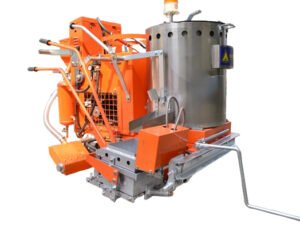
Thermoplastic Convex Line Road Marking Machine
Convex line road marking machines apply raised markings to roadways to improve driver awareness and reduce speeds in high-risk areas.
Qixia District
Mon - Fri: 9:00 - 17:30
Road marking is defined as lines, patterns, words excerpt, road signs which are applied or attached to the carriageway or kerbs or to objects within or adjacent to the carriageway for controlling, warning, guiding and informing the road users. Road marking is the application of paints or materials on the road surfaces, pavements, concrete or asphalt to communicate information to motorists and pedestrians.
Road marking helps on the road to direct, guide and regulate the road user. Road marking promote road safety & ensure smooth flow of traffic.

Solid white lines define lanes of traffic going in the same direction, or they show you the location of the shoulder of the road.

Broken or “dotted” white lines are used to show the center line between lanes.

Yellow lines show you where traffic is going in different directions.
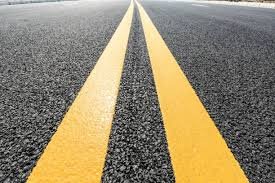
Blue is the colour of public transportation including three wheelers scooter rickshaws (TSR) and dedicated bus lanes.

Green : Green colour is used to depict bicycle lane and non motorized transportation and is marked at the intersection and gives priority to the cyclists crossing the road.

Red/Purple : Red color marking is recommended on hazardous intersections and place where pedestrians meet motorized traffic.

Longitudinal markings are placed along the direction of traffic on the roadway surface, for the purpose of indicating to the driver, his proper position on the roadway. Some of the guiding principles in longitudinal markings are also discussed below.
Longitudinal markings are provided for separating traffic flow in the same direction and the predominant color used is white. Yellow color is used to separate the traffic flow in opposite direction and also to separate the pavement edges. The lines can be either broken, solid or double solid. Broken lines are permissive in character and allows crossing with discretion, if traffic situation permits. Solid lines are restrictive in character and does not allow crossing except for entry or exit from a side road or premises or to avoid a stationary obstruction. Double solid lines indicate severity in restrictions and should not be crossed except in case of emergency. There can also be a combination of solid and broken lines. In such a case, a solid line may be crossed with discretion, if the broken line of the combination is nearer to the direction of travel. Vehicles from the opposite directions are not permitted to cross the line. Different types of longitudinal markings are centre line, traffic lanes, no passing zone, warning lines, border or edge lines, bus lane markings, cycle lane markings.
Centre line separates the opposing streams of traffic and facilitates their movements. Usually no centre line is provided for roads having width less than 5 m and for roads having more than four lanes. The centre line may be marked with either single broken line, single solid line, double broken line, or double solid line depending upon the road and traffic requirements. On urban roads with less than four lanes, the centre line may be single broken line segments of 3 m long and 150 mm wide. The broken lines are placed with 4.5 m gaps (figure 1).

Figure 1: Centre line marking for a two lane road
On curves and near intersections, gap shall be reduced to 3 metres. On undivided urban roads with at least two traffic lanes in each direction, the centre line marking may be a single solid line of 150 mm wide as in figure 2, or double solid line of 100 mm wide separated by a space of 100 mm as shown in figure 3.

Figure 2: Centre line and lane marking for a four lane road

Figure 3: Double solid line for a two lane road
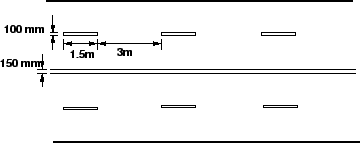
Figure 4: Centre barrier line marking for four lane road
The subdivision of wide carriageways into separate lanes on either side of the carriage way helps the driver to go straight and also curbs the meandering tendency of the driver. At intersections, these traffic lane lines will eliminate confusion and facilitates turning movements. Thus traffic lane markings help in increasing the capacity of the road in addition ensuring more safety. The traffic lane lines are normally single broken lines of 100 mm width. Some examples are shown in figure 5 and figure 6.
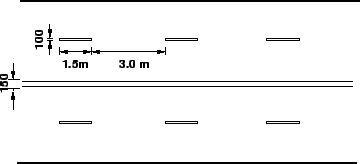
Figure 5: Lane marking for a four lane road with solid barrier line
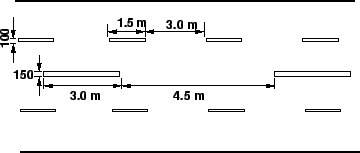
Figure 6: Traffic lane marking for a four lane road with broken centre line
No passing zones are established on summit curves, horizontal curves, and on two lane and three lane highways where overtaking maneuvers are prohibited because of low sight distance. It may be marked by a solid yellow line along the centre or a double yellow line. In the case of a double yellow line, the left hand element may be a solid barrier line, the right hand may be a either a broken line or a solid line . These solid lines are also called barrier lines. When a solid line is to the right of the broken line, the passing restriction shall apply only to the opposing traffic. Some typical examples are shown in figure 7 and figure 8.

Figure 7: Barrier line marking for a four lane road

Figure 8: No passing zone marking at horizontal curves
In the latter case, the no passing zone is staggered for each direction.
Warning lines warn the drivers about the obstruction approaches. They are marked on horizontal and vertical curves where the visibility is greater than prohibitory criteria specified for no overtaking zones. They are broken lines with 6 m length and 3 m gap. A minimum of seven line segments should be provided. A typical example is shown in figure 9
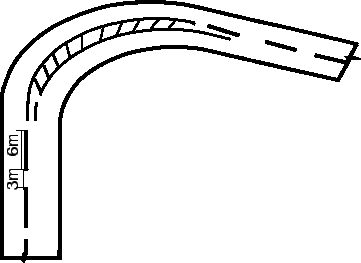
Figure 9: Warning line marking for a two lane road
Edge lines indicate edges of rural roads which have no kerbs to delineate the limits upto which the driver can safely venture. They should be at least 150 mm from the actual edge of the pavement. They are painted in yellow or white.
All the lines should be preferably light reflective, so that they will be visible during night also. Improved night visibility may also be obtained by the use of minute glass beads embedded in the pavement marking materials to produce a retroreflective surface.
Transverse markings are marked across the direction of traffic. They are marked at intersections etc. The site conditions play a very important role. The type of road marking for a particular intersection depends on several variables such as speed characteristics of traffic, availability of space etc. Stop line markings, markings for pedestrian crossing, direction arrows, etc. are some of the markings on approaches to intersections.
Stop line indicates the position beyond which the vehicles should not proceed when required to stop by control devices like signals or by traffic police. They should be placed either parallel to the intersecting roadway or at right angles to the direction of approaching vehicles. An example for a stop line marking is shown in figure 10.

Figure 10: Stop line marking near an intersection
Pedestrian crossings are provided at places where the conflict between vehicular and pedestrian traffic is severe. The site should be selected that there is less inconvenience to the pedestrians and also the vehicles are not interrupted too much. At intersections, the pedestrian crossings should be preceded by a stop line at a distance of 2 to 3m for unsignalized intersections and at a distance of one metre for signalized intersections. Most commonly used pattern for pedestrian crossing is Zebra crossing consisting of equally spaced white strips of 500 mm wide. A typical example of an intersection illustrating pedestrian crossings is shown in figure 11.

Figure 11: Pedestrian marking near an intersection
In addition to the warning lines on approaching lanes, directional arrows should be used to guide the drivers in advance over the correct lane to be taken while approaching busy intersections. Because of the low angle at which the markings are viewed by the drivers, the arrows should be elongated in the direction of traffic for adequate visibility. The dimensions of these arrows are also very important. A typical example of a directional arrow is shown in figure 12.
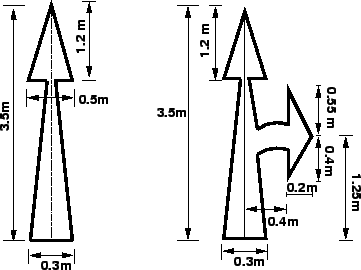
Figure 12: Directional arrow marking
Physical obstructions in a carriageway like traffic island or obstructions near carriageway like signal posts, pier etc. cause serious hazard to the flow of traffic and should be adequately marked. They may be marked on the objects adjacent to the carriageway.
The obstructions within the carriageway such as traffic islands, raised medians, etc. may be marked by not less than five alternate black and yellow stripes. The stripes should slope forward at an angle of 45$^\circ$ with respect to the direction of traffic. These stripes shall be uniform and should not be less than 100 m wide so as to provide sufficient visibility.
Sometimes objects adjacent to the carriageway may pose some obstructions to the flow of traffic. Objects such as subway piers and abutments, culvert head walls etc. are some examples for such obstructions. They should be marked with alternate black and white stripes at a forward angle of 45° with respect to the direction of traffic. Poles close to the carriageway should be painted in alternate black and white up to a height of 1.25 m above the road level. Other objects such as guard stones, drums, guard rails etc. where chances of vehicles hitting them are only when vehicle runs off the carriageway should be painted in solid white. Kerbs of all islands located in the line of traffic flow shall be painted with either alternating black and white stripes of 500 mm wide or chequered black and white stripes of same width. The object marking for central pier and side walls of an underpass is illustrated in figure 13.

Figure 13: Marking for objects adjacent to the road way
Wherever there is a change in the width of the road, or any hazardous location in the road, the driver should be warned about this situation with the help of suitable road markings. Road markings showing the width transition in the carriageway should be of 100 mm width. Converging lines shall be 150 mm wide and shall have a taper length of not less than twenty times the off-set distance. Typical carriageway markings showing transition from wider to narrower sections and vice-versa is shown in figure 14. In the figure, the driver is warned about the position of the pier through proper road markings.

Figure 14: Approach marking for obstructions on the road way
It is a series of short, white blocks perpendicular to the road. It is used, for example, in places where you can change lanes. For example, on motorways where you can drive from the acceleration lane into the main carriageway.

Figure 15: Block marking
Arrow road signs serve two primary purposes. First, they warn drivers of upcoming changes in traffic flow. Second, they guide vehicles around unexpected obstacles or closures. These functions are vital for maintaining order on the roads.
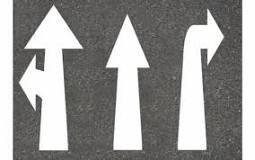
Figure 16: Arrow Marking
Directional road markings play a critical role in managing traffic flow, ensuring safety, and providing clear instructions to drivers. These markings guide drivers on when to stop, yield, or proceed, helping to avoid confusion at junctions and busy streets. Among the most common directional road markings are “Give Way,” “Stop,” “Keep Clear,” and directional arrows, all of which contribute to safer roads and improved traffic efficiency.

Figure 17: Directional marking
Facility marking, often referred to as floor marking or industrial marking, encompasses a range of visual cues, signs, and markings strategically placed within a facility, workplace safety and organization. These markings serve as a form of visual communication, conveying important information to employees, visitors, and stakeholders. They can take various forms, including lines, symbols, colors, and text, and are applied to floors, walls, equipment, and other surfaces.
Information to guide, regulate, or warn the road user may also be conveyed by inscription of word message on road surface. Characters for word messages are usually capital letters. The legends should be as brief as possible and shall not consist of more than three words for any message. Word messages require more and important time to read and comprehend than other road markings. Therefore, only few and important ones are usually adopted. Some of the examples of word messages are STOP, SLOW, SCHOOL, RIGHT TUN ONLY etc. The character of a road message is also elongated so that driver looking at the road surface at a low angle can also read them easily. The dimensioning of a typical alphabet is shown in figure 18.
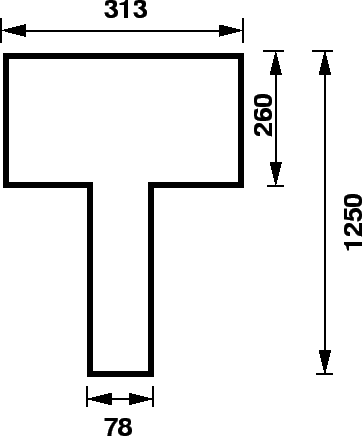
Figure 18: Typical dimension of the character T used in road marking
The marking of the parking space limits on urban roads promotes more efficient use of the parking spaces and tends to prevent encroachment on places like bus stops, fire hydrant zones etc. where parking is undesirable. Such parking space limitations should be indicated with markings that are solid white lines 100 mm wide. Words TAXI, CARS, SCOOTERS etc. may also be written if the parking area is specific for any particular type of vehicle. To indicate parking restriction, kerb or carriage way marking of continuous yellow line 100 mm wide covering the top of kerb or carriageway close to it may be used.
The road marking ES-308P retro reflectometer tester is a portable on-site measuring instrument, used for measuring the retro reflection characteristic of road marking paints/lines. It is to simulate the brightness of road marking that can be seen by the driver under the illumination of motor vehicles at night, and the measured parameter is the coefficient of retro reflection brightness at night, namely, RL value. It is featured by free preheating, small measurement error, out-of-the-box and so on. This is a necessary instrument for the production, quality supervision, engineering construction, supervision and other units to measure the retro reflection performance of road marking. The ES-308P retrorflectometer tester instrument is suitable for all types of road markings. Retro reflectometer works in accordance with EN 1436 , ASTM E 1710 (RL).

Retro reflectometer tester
To conclude, road marking plays vital role in controlling road traffic, communicating directional information to motorists and pedestrains. The essential purpose of road markings is to guide and control traffic on a highway. They supplement the function of traffic signs. The markings serve as a psychological barrier and signify the delineation of traffic path and its lateral clearance from traffic hazards for the safe movement of traffic. Hence they are very important to ensure the safe, smooth and harmonious flow of traffic. Various types of road markings like longitudinal markings, transverse markings, object markings and special markings to warn the driver about the hazardous locations in the road etc. will be discussed in detail in this chapter.
Road markings are aids to control traffic by exercising psychological control over the road users. They are made use of in delineating the carriage way as well as marking obstructions, to ensure safe driving. They also assist safe pedestrian crossing. Longitudinal markings which are provided along the length of the road and its various classifications were discussed. Transverse markings are provided along the width of the road. Road markings also contain word messages, but since it is time consuming to understand compared to other markings there are only very few of them. Markings are also used to warn the driver about the hazardous locations ahead. Thus road markings ensure smooth flow of traffic providing safety also to the road users. The following web link give further insight in to the road markings: mutcd.fhwa.dot.gov/pdfs/200311/pdf-index.htm.

Convex line road marking machines apply raised markings to roadways to improve driver awareness and reduce speeds in high-risk areas.

A portable light tower is a self-contained lighting unit that is easily moved and used in various locations

High pressure water blasting road marking removal machine takes advantage of high pressure water blasting to remove the marking lines without damage to road surfaces.

Thermoplastic flat line road marking machine, Thermoplastic convex line road marking machine, Airless Spray Cold Paint Road Marking Machine, Two-component Road Marking Machine

Road marking plays vital role in controlling road traffic, communicating directional information to motorists and pedestrains.

Road Roller Machine Categories A road roller is a compactor-type engineering vehicle used to compact soil, gravel, concrete, or asphalt in the construction of roads and foundations.